25 August, 2000
Woke up and ate some oatmeal. Anderson and John left in the Zodiac to
retrieve the nets that we set last night. The rest of us decided to visit
the old dwellings that could be seen from a distance as a pile of rocks. We
pulled Dr. Radtke in his cart over the mossy landscape. The dwelling area
seemed to have sleeping spaces for 4-5 people. There were narwhal bones in
scattered locations that had been bleached by the sun. Rocks had been laid
around the sleeping "nests" of moss and grass. Green and black lichen
covered the rocks. Such places have been dated using the growth rates of
lichen.
When we got back to the camp, the fishermen had returned with their catch.
We sorted through the nets with a device similar to a crochet hook to
untangle the gills from the fine filament. The catch was good in size range
and numbers of spawning females. Some of the spawning females were only one
third the size of the others. They looked like juveniles next to the larger
fish. The eggs that they exuded were the same size, but the guess was there
would be fewer of them. Dr. Radtke and John Babaluk said they were
probably residents in the lake, who were not migrating out to sea and back,
thus being smaller in size without the advantage of more plentiful food
sources. We took some of the fish and cut off their heads for the study
after sizing and sexing them.. Sex is determined by looking at the inside of
the body cavity. The ovaries are grainy with eggs and run a third of the
body cavity, while the male gonads are more milky in color and finely
grained, running the length of the body cavity.
Wendy fried up the fillets for dinner and made pasta flavored with the dried
potato soup mix. The dried potato flavored pasta tasted like it sounds, but
the fish were delectable and more than made up for the lack of flavor in the
pasta. We all ate our fill and then started to break down camp. We took
down the tents, folded the nets, took the boat apart, and packed everything
in one area so we could easily load the helicopter. We then debated whether
the helicopter would arrive at 8PM Thule time or Greenlandic time.
Apparently on the airforce base the time is one hour later to be closer to
mainland USA time. They arrived at 8:30PM Greenlandic time and the first
group took off with most of the gear. John, Wendy, and I stayed behind
along with Frank and "Spot" who would return by boat. Wendy had gone with
Frank to take down their camp and to collect their fish samples from the
fjord. The helicopter returned in a short time to pick us up and we landed
at the fjord to get Wendy; this is where I had camped with Mas Ole a few
days before. We flew back to Qaanaq. It was interesting to view the same
coastline I had gone along by boat from the air; I was really starting to
enjoy the helicopter rides more and more .
Upon our return to the Alderhous, we found a hot meal of narwhal soup for
us but the community's mood was subdued. There had been a murder and
attempted suicide in the time we had been gone, leaving three children
without their mother and a father with a self inflicted wound and under
arrest.
After eating we waited for the kitchen to be free so that we could use the
space to prepare our samples. We sized and sexed the fish then cut off
their heads, labeled and bagged them for the freezer. Later we would
dissect out the otoliths. We set up an assembly line to speed the process.
The last step was for Wendy to gut and freeze the bodies for food for the
Alderhous. We finished around 3AM. I took a shower and went to sleep with
no noise but the occasional sound of the sled dogs howling in the cold air.
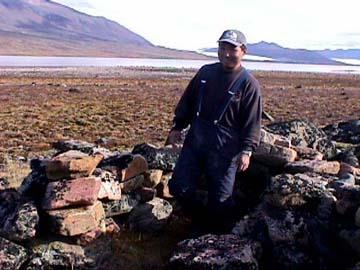
Frank standing in one of the sleeping places at the old Inuit dwelling.
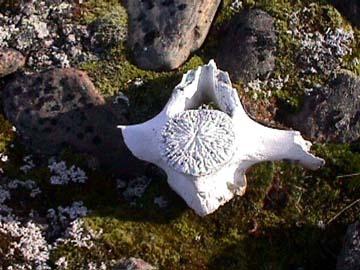
Bleached narwhal bone at the dwelling site.

Dr. Ratdke, Frank Angmalortok', Ammalortortalik, and a sample of the catch.
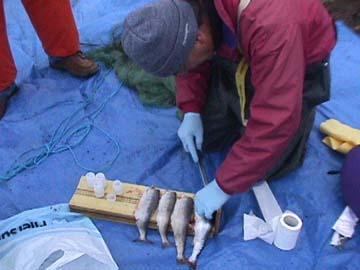
John Babaluk taking a sample of fish flesh for the genetics study.
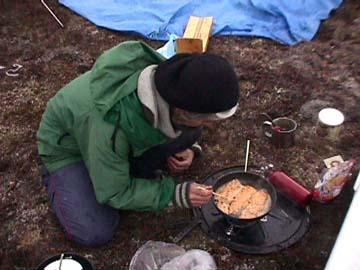
Wendy cooking up some char for a delicious dinner.

A dinner of narwhal at the Alderhous.

John and I at work as part of the sampling assembly line.
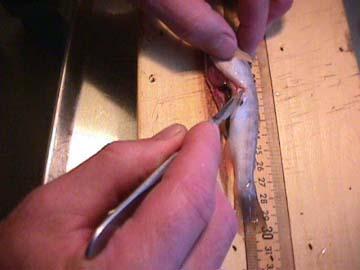
Fish sexing.

Contact the TEA in the field at
.
If you cannot connect through your browser, copy the
TEA's e-mail address in the "To:" line of
your favorite e-mail package.
|
